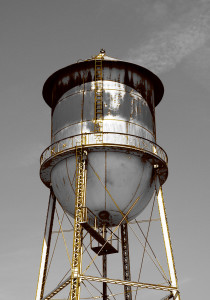
Regardless of the effectiveness of water treatment efforts, poor conditions in distribution system storage tanks can decrease the quality of finished water. In order to prevent this from occurring, regular inspection and cleaning of storage tanks is essential and mandated in most states. Doing so regularly protects not only water quality and safety, it protects the asset from hidden corrosion and degraded coatings.
Dirty Tanks Degrade Water Quality
Dirty tanks can cause a variety of problems in water, including:
- Health risks from bacteria hidden in silt and biofilms
- Taste and odor problems
- Dirty water complaints
- Elevated disinfection by-products
- Consume chlorine residuals
Cleaning Regulations and Recommendations
State regulations covering water storage tank inspection and cleaning vary. While some states require the draining and cleaning of tanks every three to five years, others require annual tank inspection without any mandatory draining or cleaning. Regardless of government regulations, regular inspection and cleaning of water storage tanks is still recommended. In fact, according to the AWWA Manual of Water Supply Practices, metal water storage tanks should be drained, inspected, cleaned and thoroughly disinfected at least once every three years. In areas where excess sediment is a known problem, the AWWA recommends annual cleanings. Keeping water storage units clean offers many benefits to consumers and operators alike, including:
- Fewer consumer health risks
- Fewer customer complaints
- Improved water quality
- Reduced treatment expenses by eliminating disinfectant demand
- Fewer unplanned expenses
If operators are opposed to a regular inspection and cleaning schedule, they can determine whether cleaning is needed by monitoring the disinfection levels of the water that enters and exits a storage facility in order to determine if additional cleaning is needed. In fact, utilities can even invest in a continuous monitoring system that will detect problems such as fluctuating temperatures and increased turbidity as soon as they occur. Although this type of system is typically expensive, it provides immediate results and can greatly reduce the chances of dirty water being delivered to customers and pay for itself in preventative maintenance.
Methods of Water Tank Inspection and Cleaning

Chemical Cleaning
Chemical cleaning is one of the best ways to completely clean a water storage tank. This method may use a number of chemicals ranging from sophisticated cleaning formulas to simple acids. Keep in mind that, although simple acids are less expensive than other chemicals, they may cause damage to the walls of the tank. Depending on the chemicals utilized, as well as other factors, the cost of chemical cleaning ranges from $3,000 to $6,500. Over the past few years, advanced chemical cleaning with NSF standard 60-certified chemical formulations have been developed to effectively clean tanks while minimizing downtime and structure damage. These low pressure spray on/spray off chemicals provide a fast, convenient and safe method to remove biofilm and scale from tanks.
Power Washing
The interior of tanks can be power washed to remove accumulated biofilms. Before this method can be utilized, the tank must first be drained. In order to reach the highest portions of the tank, crews may need to use scaffolding. Power washing is typically less expensive than chemical cleaning, with costs ranging from $3,000 to $5,000. However, it does not remove biofilms or scale as effectively, leaving a potential for regrowth. Power washing can also damage tanks in some cases by damaging coatings or pitting concrete that then provides biofilms additional attachment points.
Divers
Divers can inspect a tank and remove sediment without draining it first. This method is less expensive than either chemical cleaning or power washing, with typical prices ranging from $1,500 to $3,000. However, this method also has limits. Because divers are tethered to an air source outside of the tank, they cannot move freely. Removing biofilms is difficult for divers, and cleanings performed won’t be as effective as they would be with more expensive methods. Divers can remove sediment in tanks but cannot clean wall surfaces that are significantly greater than floor surfaces.
Remotely Operated Vehicles
The least expensive tank inspection and cleaning method involves the use of Remotely Operated Vehicles, or ROVs, to vacuum sediment. This method costs only $500 to $1,500, depending on the size of the tank and if sediment removal is included. ROVs can be utilized without draining the tank. However, because the ROV cannot reach all areas of the tank, thorough inspection and cleaning won’t be possible in these areas and ROVs cannot clean wall surfaces either, similar to the drawback of tank divers. Likewise, because ROVs are not able to thoroughly remove surface attachments, even areas that can be reached by the ROV may not be cleaned completely. Finally, unless the project includes sediment removal, ROVs typically avoid the bottom of the tank, where disturbed sediments may affect the turbidity of the water.
DOWNLOAD IMPROVED CHLORINE RESIDUALS AFTER TANK CLEANING
Photo credit: davedehetre / Foter / CC BY-NC
Photo credit: kevin dooley / Foter / CC BY

